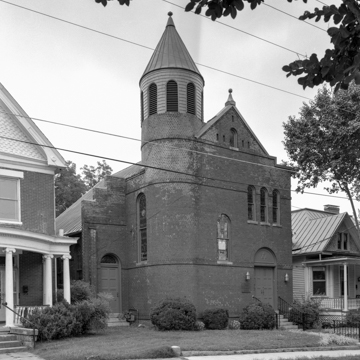Danville's German Reformed Jewish congregation, founded in 1893, chose Romanesque Revival for their synagogue. While reminiscent of many synagogues built in Germany in the latter part of the nineteenth century, the congregation also wanted it to be identifiable as an American house of worship, and the style was popular at the turn of the twentieth century. Although neither red brick nor Romanesque Revival is unusual, the temple nevertheless is distinctive with its irregular placement of round-arched windows in the gable-end entrance facade and the positioning of the semicircular tower with its louvered belfry capped by a conical roof. The tower has no entrance to it either inside or out. The entrance leads into a modest vestibule in front of an open sanctuary. The stark plainness of the facade is broken by belt courses that continue around the tower to link the two together.
You are here
Temple Beth Sholom
If SAH Archipedia has been useful to you, please consider supporting it.
SAH Archipedia tells the story of the United States through its buildings, landscapes, and cities. This freely available resource empowers the public with authoritative knowledge that deepens their understanding and appreciation of the built environment. But the Society of Architectural Historians, which created SAH Archipedia with University of Virginia Press, needs your support to maintain the high-caliber research, writing, photography, cartography, editing, design, and programming that make SAH Archipedia a trusted online resource available to all who value the history of place, heritage tourism, and learning.















